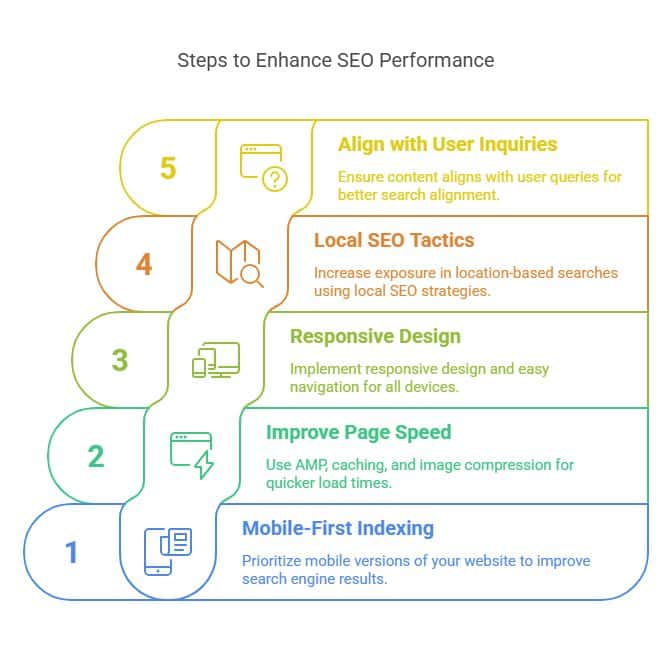
Adopting a mobile-first indexing, which prioritizes the mobile version of your website as the main version, is the first step towards optimizing your mobile site for search engines. Implement responsive design to ensure your site adjusts seamlessly across various devices and screen sizes. Enhance user experience by prioritizing fast-loading pages, optimizing touch interactions, and simplifying navigation for ease of use. Make sure images are compressed for quicker load times, and keep text concise yet engaging. Consider using Accelerated Mobile Pages (AMP) to boost speed further, and add structured data to improve how search engines understand and rank your content. These steps will help ensure your site is both user-friendly and search engine optimized. Incorporating voice search and local SEO strategies enhances your reach. Dive deeper into these mobile optimization techniques in technical SEO to fully unlock your mobile site’s potential and drive success.
Key Takeaways
- To improve search engine results, prioritize mobile versions of your website by implementing mobile-first indexing.
- Improve page speed by using Accelerated Mobile Pages (AMP), caching, and image compression to achieve quicker load times.
- Use responsive design and easy-to-use navigation to improve user experience and make sure it works on all devices.
- Increase exposure and relevancy in location-based searches by utilizing local SEO tactics and structured data.
- For improved alignment with user inquiries, combine conversational keywords and natural language with voice search optimization.

Understand Mobile-First Indexing
Optimizing your mobile site for search engines requires an understanding of Google’s mobile-first indexing. Google gives your site’s mobile version priority when calculating rankings since mobile search trends continue to rule the digital world. With more people using smartphones than ever before to access the internet, this change indicates the increasing significance of mobile user behavior. As a result, the overall search engine rating of your website now heavily depends on how well it performs on mobile devices.
Beyond conventional SEO techniques, mobile ranking variables necessitate a sophisticated strategy to stay competitive. For example, as more people rely on speech-activated gadgets like smartphones and smart speakers, voice search optimization is becoming more and more important. Your information can become more relevant and accessible by using natural language and question-based questions, which will also increase its visibility in mobile search results.
Local SEO strategies are also essential in the mobile-first era. Many users perform location-based searches while on the go, making it imperative for businesses to optimize their online presence for local searches. This includes ensuring accurate business listings, utilizing location-specific keywords, and encouraging customer reviews to boost credibility and engagement.
Understanding mobile user behavior is fundamental to crafting an effective mobile SEO strategy. Users expect fast-loading, easily navigable sites that provide immediate access to information. Focusing on mobile-friendly design and content is crucial, as slow or cumbersome sites can lead to high bounce rates and diminished rankings.
Adapting to Google’s mobile-first indexing involves a comprehensive understanding of these elements, ensuring your mobile site remains competitive and visible in an ever-evolving digital environment.
Implement Responsive Design

Implementing responsive design is a critical component of optimizing your mobile site for SEO, as it ensures that your website automatically adjusts to fit various screen sizes and devices. This approach not only enhances the user experience but also aligns with Google’s mobile-first indexing strategy, making it an essential practice in today’s mobile design trends.
A responsive site is built to adapt, reflecting the need for fluid layouts that cater to diverse user preferences and behaviors.
To effectively implement responsive design, consider the following aspects:
- Responsive frameworks: Utilize robust frameworks like Bootstrap or Foundation, which provide a solid foundation for building responsive websites. These frameworks come with pre-designed components and grid systems, simplifying the development process.
- Viewport settings: Properly configure the viewport settings to control your website’s layout on different devices. This involves defining the width and scale of the page to ensure optimal display across all screen sizes.
- User interface: Design an intuitive user interface that seamlessly transitions between desktop and mobile devices. This includes using flexible images and media queries to maintain visual consistency and accessibility.
- Touch interactions: Optimize touch interactions by increasing button sizes and spacing, ensuring that users can easily navigate the site on touch devices. This attention to detail enhances usability and reduces frustration.
Prioritize Page Speed

Speed is a crucial factor in optimizing your mobile site for SEO, as it directly impacts user experience and search engine rankings. In today’s fast-paced digital environment, users expect swift interactions, and search engines prioritize sites that meet these expectations.
To enhance page speed effectively, begin with comprehensive mobile testing to identify bottlenecks that hinder performance. By leveraging tools that assess core web vitals, such as loading performance, interactivity, and visual stability, you can gain a clearer understanding of areas needing improvement.
Analytics tracking further aids in pinpointing slow-loading pages or elements, providing valuable insights into user behavior and site efficiency. Implementing Accelerated Mobile Pages (AMP) can offer significant advantages by stripping down non-essential elements and focusing on delivering content quickly.
AMP optimizes mobile experiences by ensuring pages load almost instantly, which can contribute to higher engagement and lower bounce rates.
When considering touch elements, ensure they are responsive and do not impede page speed. Overly complex or unresponsive touch elements can frustrate users and increase load times, negatively affecting both user experience and SEO.
Streamlining these elements can improve interaction fluidity and enhance overall site performance.
Optimize Images

Optimizing images is paramount for enhancing mobile site SEO, as images often constitute the bulk of a webpage’s load time. The efficiency of image optimization can significantly impact user experience and search engine rankings. By employing effective strategies, webmasters can ensure that their mobile sites remain competitive and accessible.
To begin with, image compression techniques are essential. By reducing the file size without compromising quality, loading times decrease, improving site speed. There are numerous tools available that make this process both simple and effective.
Additionally, the alt text importance cannot be overstated. Alt text provides context to search engines, enhancing accessibility and SEO by describing the image content. This is particularly beneficial for users relying on screen readers.
Responsive image sizes also play a crucial role. Ensuring that images are appropriately sized for different devices prevents unnecessary data usage and enhances the performance of mobile sites. This adaptability caters to the variety of screen resolutions and dimensions in the mobile landscape.
Furthermore, image format selection is vital. Choosing modern formats like WebP can yield smaller file sizes and better compression compared to traditional formats like JPEG and PNG. This choice can lead to faster load times and improved SEO outcomes.
Use Accelerated Mobile Pages

While optimizing images significantly enhances mobile site performance, leveraging Accelerated Mobile Pages (AMP) can further improve SEO by ensuring faster loading times and superior user experiences.
AMP is an open-source framework designed to create lightweight mobile pages that load almost instantaneously. This speed is critical, as it directly impacts user retention and engagement, both of which are vital metrics for search engine optimization.
The AMP benefits are numerous. Primarily, AMP reduces page loading time, which can significantly decrease bounce rates and increase the time users spend on your site. This is achieved by stripping down HTML to its essentials, allowing AMP pages to load faster than their traditional counterparts.
When considering AMP vs. HTML, the streamlined nature of AMP provides a distinct advantage in performance, particularly for content-heavy sites.
AMP implementation is straightforward, involving the use of AMP HTML components, which are designed to ensure reliability and speed. However, it is essential to maintain AMP analytics to track user interactions and page performance. This can be accomplished through AMP-compatible analytics tools, which offer insights into user behavior, helping you fine-tune your strategy for maximum impact.
Looking towards the AMP future, its adoption continues to grow as mobile usage increases. As more businesses recognize the importance of mobile optimization, AMP stands out as a pivotal tool in enhancing site speed and user experience.
Simplify Navigation

Facilitating seamless user experiences on mobile sites, simplifying navigation is paramount for effective SEO optimization. A well-structured navigation system not only enhances usability but also boosts search engine visibility. Mobile users demand quick access to information, and achieving this begins with the strategic design of mobile menus. These menus should be intuitive and concise, enabling users to find their desired content effortlessly.
Effective navigation design encompasses several key elements:
- Touch Gestures: Ensure that navigation can be easily accessed through common touch gestures, such as swiping or tapping, which are familiar to mobile users. This reduces friction and accelerates the browsing process.
- Voice Search: With the increasing prevalence of voice-activated devices, integrating voice search within your navigation strategy can provide a quick alternative for users seeking specific information without typing.
- Thumb Zones: Recognize the importance of thumb zones, the areas of a screen most easily reachable by a user’s thumb. Designing navigation elements within these zones enhances comfort, minimizing the effort required to interact with your site.
- Content Hierarchy: Establish a clear content hierarchy to guide users naturally through your site. Prioritize critical information and ensure that secondary content does not overshadow the primary message.
Simplified navigation contributes to a streamlined user journey, reducing bounce rates and encouraging longer site visits.
Enhance User Experience

To elevate your mobile site’s SEO performance, enhancing user experience is crucial. This can be achieved by incorporating several strategies that cater specifically to mobile users’ needs and preferences. One of the primary considerations is the integration of mobile accessibility features. Ensuring your site is accessible to all users, including those with disabilities, can significantly improve user satisfaction and engagement. Features like scalable text, screen reader compatibility, and alternative text for images are essential for broadening accessibility.
In addition to accessibility, designing touch friendly elements is vital. Mobile users interact with websites using their fingers, so buttons and links should be adequately sized and spaced to prevent accidental clicks. This design consideration not only enhances usability but also reduces frustration, encouraging users to stay longer on your site.
Voice search optimization is another critical factor in improving user experience. As more users rely on voice commands to search for information, ensuring your mobile site is optimized for voice search can lead to better engagement. This involves using natural language in content and focusing on conversational keywords.
Implementing local search strategies is also beneficial, particularly for businesses that depend on local clientele. Ensuring that your site is optimized for local searches can help attract nearby users. This includes having accurate business information and leveraging local keywords.
Lastly, actively seeking mobile user feedback allows for continuous improvement. By understanding user preferences and pain points, adjustments can be made to enhance the overall experience, ultimately boosting your site’s SEO performance and customer satisfaction.
Focus on Mobile Content

In the realm of mobile SEO, focusing on mobile content is paramount for ensuring that your site meets the expectations and behaviors of mobile users. A well-crafted mobile content strategy is essential for capturing the attention of users who demand quick and seamless access to information.
Understanding mobile user behavior is crucial; users typically engage differently on mobile devices compared to desktops, often favoring content that is easily digestible and visually appealing.
To optimize your mobile site effectively, consider these key elements:
- Concise Mobile Messaging: Aim for brevity in your text. Mobile users prefer content that is straightforward and to the point, allowing them to grasp the core message without excessive scrolling.
- Engaging Mobile Visuals: Integrate high-quality images and videos that load quickly and enhance the user experience. Visual content should be optimized for mobile screens, ensuring clarity and engagement.
- Mobile Content Accessibility: Ensure that all users, including those with disabilities, can access your content. This includes using appropriate alt text for images and ensuring that your site is navigable with assistive technologies.
- Responsive Design: Your site’s layout should adapt smoothly to different screen sizes, providing a consistent experience across all devices. This not only improves usability but also impacts your SEO positively.
Utilize Structured Data
Leveraging structured data is a critical practice for enhancing your mobile site’s SEO performance. By implementing structured data types, businesses can improve their visibility on search engines and provide users with enriched search results.
Structured data, often marked up using schema markup, helps search engines understand the content of your mobile site more effectively. This understanding can lead to the generation of rich snippets, which are enhanced search results that display additional information, such as ratings or event details, directly on the search results page.
Incorporating schema markup is particularly beneficial for businesses aiming to bolster their local SEO. For instance, local businesses can use structured data to provide search engines with key details such as their address, phone number, and operating hours, which can enhance visibility in location-based search results.
This is crucial for attracting nearby customers and improving the overall user experience on mobile devices, where local searches are increasingly prevalent.
Moreover, structured data plays a significant role in optimizing for voice search, an area growing in importance as more users rely on voice-activated devices. By clearly defining the content on your mobile site through structured data, you increase the likelihood that your site will be selected as a relevant response to voice queries, which often seek concise and direct answers.
Final Thoughts
Optimizing your mobile site for SEO is crucial in today’s mobile-first digital landscape. By focusing on responsive design, improving page speed, simplifying navigation, and leveraging techniques like AMP and structured data, you can enhance both user experience and search engine visibility. Additionally, incorporating local SEO, voice search optimization, and mobile-friendly content strategies ensures that your site remains competitive and effective in attracting mobile users. Implement these best practices to fully unlock your site’s potential and drive long-term success.
Ready to take your mobile site to the next level? Contact Syville Gacutan, an experienced SEO Specialist in the Philippines. Syville can help you optimize your site for mobile users, boost search visibility, and achieve sustainable SEO success. Connect today for expert guidance and proven SEO solutions!